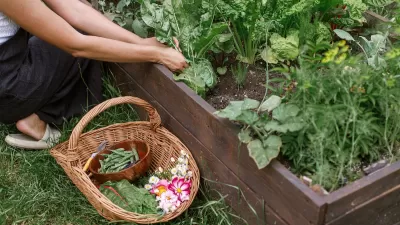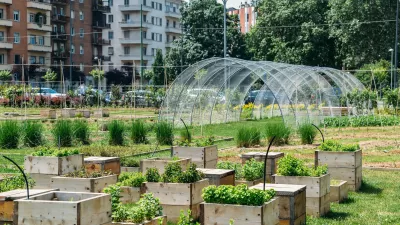Urban agriculture is a promising solution to a variety of ills afflicting our increasingly urbanizing planet. Milton Keynes, Britain's largest New Town of the 20th Century, is forging a path towards food sovereignty by growing its urban farms.
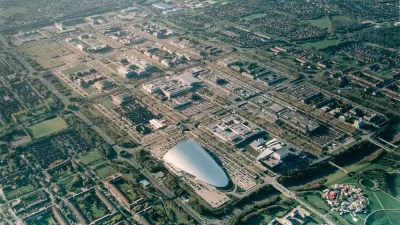
The clash of increasing urbanization and the global food system is causing concern in social, environmental, economic, and political realms all over the world. As a result of the urbanization that is methodically taking over the planet, the degradation of the environment is increasing. One solution to the loss of agricultural land to development and growing issues of food insecurity is urban agriculture.
This form of farming supports and encourages the consumption of locally grown food, and urban centres across the globe are now hopping on the bandwagon in order to reap the benefits. However, urban agriculture is not a new fad. The practice dates back to at least 16th century Peru, where a self-reliant urban agricultural system was established in the Andes mountain city of Machu Picchu. In 19th century France, biointensive agriculture fed local communities in urban centers. [1]
Urban agriculture helps to address a myriad of problems, like the dangers of harmful runoff, the climate costs of industrial food production and distribution, and the heat island effect so many cities experience. But perhaps more significantly, it deposits the freedom of food choice for a community right where it belongs: within the community. Urban farmers grow what they wish for the good of their own livelihood as well as for the good of the community. With the practice of urban agriculture, no longer is food production banished to the fringes of country wilderness; it becomes a visible and viable solution for twenty-first century cities and a means to achieve food sovereignty.
The concept of food sovereignty was publicly conceptualized by Via Campesina at the World Food Summit in Rome in 1996. But it wasn’t until five years later, when a group of NGOs delved into the topic, that people sat up and took notice. The group described food sovereignty as the right of peoples, communities, and countries to define their own agricultural, labor, fishing, food, and land policies which are ecologically, socially, economically, and culturally appropriate to their unique circumstances. [2]
Undoubtedly, some have embraced this quest for sovereignty more readily than others. Cuba is a good example of this. Since the revolution of 1959, Cuba has become a model for urban agriculture. The “special period” after the fall of the Soviet Union in the early 1990s caused food shortages throughout the country. From 1991 to 1995, it was estimated that food availability in major Cuban cities, like Havana, declined as much as 60%.[3] The lesson was learned.
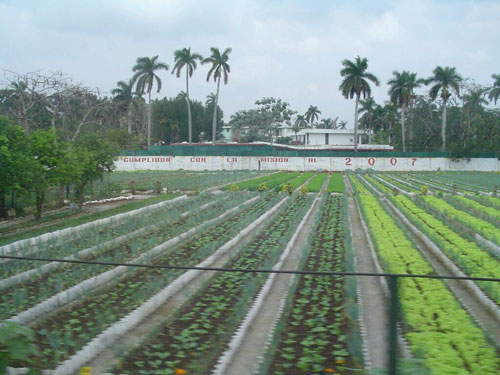
Today, urban agriculture in Cuba is thriving. Havana, a city that once experienced one of the most acute economic crises in the country’s history, now follows a method described as “production in the community, by the community, for the community”. The method has achieved success. In 2007, agriculture in Cuba was comprised, in a relatively significant part, of urban agriculture, to the tune of 14.6%.[4] The numbers are growing.
A number of other places have grabbed at the baton. But it is one town in particular that shows tremendous promise for a productive mix of urban growth - both people and food. The place is Milton Keynes, a large town in Buckinghamshire, almost 100 km northwest of London.

While formally designated a new town in 1967, Milton Keynes has a long history that dates back to the 2nd millennium BC. The Middle Ages saw the creation of eighteen villages, most of which still exist and form the district cores. The establishment of the town was birthed as a method of solving housing problems in London, but the town has grown substantially since, now boasting a population of approximately 230,000. From 2001 to 2011 alone, the population experienced a surge of 40,000 new residents.[5] The vision for the town has grown too.
Land use planning policies originally dictated a more modest town plan. For instance, no building was allowed to be taller than the tallest tree. This changed when the Milton Keynes Partnership decided the town needed “landmark buildings”. The change paid off. Over time, the town has seen more aggressively planned neighbourhoods. In 2004, an expansion plan for Milton Keynes was announced which foresees doubling of the population by year 2026.
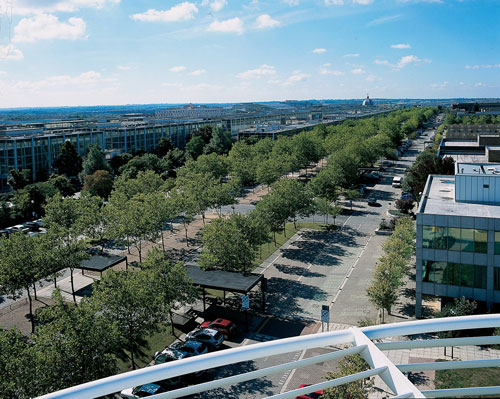
Though there are a number of issues the town must still address, including transportation and education and training initiatives for the townspeople, sustainable development is one area in which they have successfully maintained a dogged focus. They have made this a central concern, something that can serve as an inspiration to a number of other cities, primarily larger ones that still have their work cut out for them in catching up to frontrunners like Milton Keynes.
In preparation for the town’s continued growth, the government has focused its efforts on a Sustainable Communities Plan, which discusses housing development, health services, and transportation, as well as the local food economy. Other policies and papers calling for the support of urban agriculture have since been released, including the aptly named Food MK Project, which resulted in a “Food MK Action Plan”. The local food economy has grown gradually over time and the town demonstrated its hope to kick this calling into high gear by rallying representatives from Milton Keynes Council, English Partnerships, The Parks Trust, MK Primary Trust, and a number of community organizations. In doing so, Milton Keynes has solidified its position as a leader in urban agriculture.
The development of a local food system most anywhere helps support national, regional and local government policy on sustainable development, land use, health, and economic and community development. In short, so many giants can be taken down with the wide arc of a single stone. Milton Keynes is no different. And the numbers don't lie.
The MK public is catching the locally-grown-is-best bug. Food from Britain, a Non-Departmental Public Body which promoted UK food exports between 1983 and 2009, calculated that the percentage of shoppers buying local food increased by 6% in 2005 with almost 65% buying local food and a further 9% expressing an interest in buying if availability was better. [6] The numbers are still growing. This has resulted in an increased interest in local food, a growth in the number of farmers markets and box schemes, and a renewed interest in ‘growing your own’.
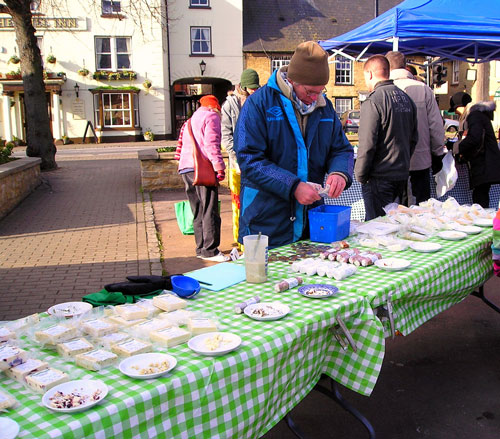
According to one report on this new initiative, there are around 60 working farms in the borough of Milton Keynes which were established over time, in conjunction with the area’s development; most are arable and livestock and two are dairies – G. Adderson in North Crawley and Hill Farm in Haversham. G. Adderson sells at local farmers markets and a milk round, which reaches into the city as far as Newport Pagnell. Hill Farm has a large ASDA contract for milk and is developing an ice cream product, which they hope to market locally.[7] This is no doubt a great starting point, but not so unique to MK that a number of other areas around the world cannot join in the revolution.
However, there are some features Milton Keynes boasts that make this region the perfect pet project, perhaps more than others. MK has an award winning beekeeper running 30 hives in various city locations and selling solely at farmers markets. There are a number of other beekeepers – in Simpson, Castlethorpe and Newton Blossomville, which may reflect the growing popularity of beekeeping.[8] Unlike most places where development has displaced agricultural uses, evidence of Milton Keynes’ agricultural heritage remains intact within the new city boundary, in village centers such as Simpson and Woughton on the Green.[9]
There is also an emerging community food sector in Milton Keynes that includes a number of community cafés and community gardens. Though there are no community supported agriculture schemes just yet, the town is quickly approaching its goal of achieving food sovereignty.
Milton Keynes is laudably unwavering in its commitment to setting a new standard in local food production. Though the advantages of a relatively small town aid in the range of success enjoyed in an initiative like this – more solidarity and community gumption are not far from the top of that list of ‘musts’ – its single-minded focus should be applauded. Bigger size and better capability elsewhere still seem to come up short when determination and united participation are lacking. These things are sorely missing from the global scene and unless more cities follow the Milton Keynes example, food security will become a much more widespread problem with dire consequences.
Christina Sgro is a planner with a private consulting firm in the Greater Toronto, Ontario area, where she works on various land development and acquisition projects. She holds a Master of Planning & Environmental Studies degree and is a member of the Ontario Professional Planners Institute.
[1] L. Redmond, "Creating Local Food Options in an Urban Setting". The New Farm Online (2004).
[2] L. Redmond, "City Farming: The Growing Revelation". Ffenyx Rising Online (2004).
[3] M.G. Novo, "Urban Agriculture in the City of Havana: A Popular Response to a Crisis". (1998).
[4] S. Koont, Sustainable Urban Agriculture in Cuba. (2011)
[5] History of Milton Keynes, Tourism and Sightseeing, 2013
[6] Food from Britain - IGD Retail and Food Service opportunities for local food, 2005
[7] Milton Keynes Partnership - The New Plan for Milton Keynes: A Strategy for Growth to 2031, 2006
[8] Milton Keynes Partnership - The New Plan for Milton Keynes: A Strategy for Growth to 2031, 2006
[9] Growing Food for a Growing City: Issues, Challenges and Opportunities, 2006

Alabama: Trump Terminates Settlements for Black Communities Harmed By Raw Sewage
Trump deemed the landmark civil rights agreement “illegal DEI and environmental justice policy.”

Planetizen Federal Action Tracker
A weekly monitor of how Trump’s orders and actions are impacting planners and planning in America.

The 120 Year Old Tiny Home Villages That Sheltered San Francisco’s Earthquake Refugees
More than a century ago, San Francisco mobilized to house thousands of residents displaced by the 1906 earthquake. Could their strategy offer a model for the present?

Opinion: California’s SB 79 Would Improve Housing Affordability and Transit Access
A proposed bill would legalize transit-oriented development statewide.

Record Temperatures Prompt Push for Environmental Justice Bills
Nevada legislators are proposing laws that would mandate heat mitigation measures to protect residents from the impacts of extreme heat.

Downtown Pittsburgh Set to Gain 1,300 New Housing Units
Pittsburgh’s office buildings, many of which date back to the early 20th century, are prime candidates for conversion to housing.
Urban Design for Planners 1: Software Tools
This six-course series explores essential urban design concepts using open source software and equips planners with the tools they need to participate fully in the urban design process.
Planning for Universal Design
Learn the tools for implementing Universal Design in planning regulations.
Clanton & Associates, Inc.
Jessamine County Fiscal Court
Institute for Housing and Urban Development Studies (IHS)
City of Grandview
Harvard GSD Executive Education
Toledo-Lucas County Plan Commissions
Salt Lake City
NYU Wagner Graduate School of Public Service


























